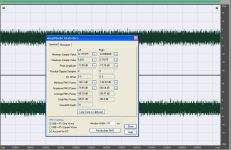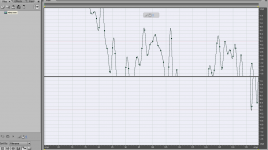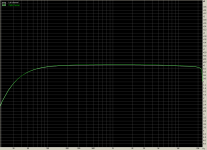Just listening at the moment, and my assessment of the "worst" hasn't changed, from my perspective: cap1 is the least of the 3, cap2 is the best, and cap3 "in the middle", but closer to cap2. Now listening 'differently' cap3 has varying 'qualities' from cap2 but still has the qualities of musical 'roundness' that I look for - going back to cap1 each time I'm aware of a hardness, an 'uncomfortableness', the sort of thing which means I would turn off the system much faster - the 'humanness' of the vocals, the ease in the trebly content is what I'm reacting to here.
My guess is that cap1 was recorded at the very start, the chain hadn't stabilised as much, cap2 and cap3 were done when everything was nicely "warmed up".
A pure guess, Mundorf is cap1 and cap2, because once it and the circuit were conditioned a bit more it produced a 'classier' sound, and cap3 is the MKT, slightly 'uncouth' in comparison.
My guess is that cap1 was recorded at the very start, the chain hadn't stabilised as much, cap2 and cap3 were done when everything was nicely "warmed up".
A pure guess, Mundorf is cap1 and cap2, because once it and the circuit were conditioned a bit more it produced a 'classier' sound, and cap3 is the MKT, slightly 'uncouth' in comparison.
Well, that's fascinating - cap1 has something about it that I'm reacting to, negatively - and it's consistent. I haven't looked at the files at all using a waveform editor so far - I think I'll pull out Audacity and try and rip them to shreds, see if I can see something buried in there ...
Otherwise, it may be some peculiarity in how that particular file is stored on my PC currently, triggering a sound change - I'll try copying once or twice to see if that makes a difference ...
Otherwise, it may be some peculiarity in how that particular file is stored on my PC currently, triggering a sound change - I'll try copying once or twice to see if that makes a difference ...
Ah, do you mean repeating the test until the result is perfect?
This can be "fixed" by making it more online with guidance of the control server and cryptography. But I'm not sure if it is worth the effort.
No much simpler than that. foobar only shows one piece of information to identify that the tracks are the ones intended for testing. The length of the track... I'll leave it up to your imagination as to how it would be trivial to mislead people with a perfect 10/10 result. It comes down to honesty. Unless the test is supervised, ABX using foobar as SY says is only useful to the person doing the test himself as there is basically no control over what the person presenting the results is listening to, you just have to take their word for it!
Tony.
The mystery continues ... in Audacity did a precise alignment of cap1 and cap2 and subtracted, better than a 70dB null - the spectrum of the diff file looks just like what Barleywater posted. Amplified the diff file so that max level matched the cap files, and played that at same volume as the originals - sounded like 'pure' noise, only if I really played tricks with my focus on the sound could I be persuaded that there was anything with 'character' in the noise.
Yet, replicated cap1 within the same directory, and there again was the same lessened subjective quality in the 2nd example of the file, as compared to cap2 - implying no 'funnies' with the PC handling ...
I'm scratching my head ...
Yet, replicated cap1 within the same directory, and there again was the same lessened subjective quality in the 2nd example of the file, as compared to cap2 - implying no 'funnies' with the PC handling ...
I'm scratching my head ...
The mystery continues ... in Audacity did a precise alignment of cap1 and cap2 and subtracted, better than a 70dB null - the spectrum of the diff file looks just like what Barleywater posted.
The 'perfect' alignment gives null below -80dB with average RMS -85dB.
I am more than sure that different hardware may make some difference during replay. Yesterday I have mentioned my experience with my "office" sound system when playing the difference file.
Attachments
Unless the test is supervised, ABX using foobar as SY says is only useful to the person doing the test himself as there is basically no control over what the person presenting the results is listening to, you just have to take their word for it!
Tony.
Unfortunately. Frankly, I could not have imagined that someone would like to cheat in a test that should give some indications about audibility of certain (possible) sound differences. In a web test, we may then stick with subjective comments and get similar reliability ....
It is quite sad, because preparation of technically correct files, aligned both in time and amplitude, takes hours. Anyway, there were answers, before the cheat has appeared, indicating that people were unable to tell any reliable difference in this last test.
No audible chirps for me, in the diff file - I was running it pretty hot, and perhaps I could have been persuaded that there was some very vague, muttering type undercurrent to the sound - but if there it was extremely subtle.
If a hardware issue, what was triggering this if the original files were so close? I had the thought, that if one created a perfect, near full level sine wave, and a second one, with that diff file added to it - and listened to the two, that the noisy one would stand out. Ah-hah, says someone, subtract one from the other, see, the difference is so tiny, how could you hear any difference between them?! ... I'm wondering if something like that is happening here?
If a hardware issue, what was triggering this if the original files were so close? I had the thought, that if one created a perfect, near full level sine wave, and a second one, with that diff file added to it - and listened to the two, that the noisy one would stand out. Ah-hah, says someone, subtract one from the other, see, the difference is so tiny, how could you hear any difference between them?! ... I'm wondering if something like that is happening here?
I am not able to answer, and do not want to supply my guesses 
Tried to avoid some technical troubles I have criticized in another thread - in fact it was the reason why I prepared these files, to behave constructively
I appreciate your impressions and sound descriptions, as always.
Tried to avoid some technical troubles I have criticized in another thread - in fact it was the reason why I prepared these files, to behave constructively
I appreciate your impressions and sound descriptions, as always.
No audible chirps for me, in the diff file...
If a hardware issue, what was triggering this if the original files were so close? I had the thought, that if one created a perfect, near full level sine wave, and a second one, with that diff file added to it - and listened to the two, that the noisy one would stand out. Ah-hah, says someone, subtract one from the other, see, the difference is so tiny, how could you hear any difference between them?! ... I'm wondering if something like that is happening here?
Unfortunately I didn't spend much time on this thread before I found that Foobar feature (I think I was trying to find a "repeat" feature which seems doesn't exist in Foobar) on the first reading of the thread.
But I think from quick listening I already have preliminary guess, which was correct. Only after confirmation from PMA I started to do serious listening and ABXing cap1 and cap3. From here I cannot say that the difference is tiny, well, it's subjective.
But I have a guess why I can hear it. It's an old story. Again, my speaker.
Remember when I said there was no difference between A and B in Mooly's test? I used Dynaudio bookshelf. Because you said it was obvious difference, I pulled my reference speaker and indeed it was so obvious then. I thought I were in good physical condition but who knows, it could be the speaker, which I know very well is the most resolving I have ever heard.
I was not a THD addict, actually I am fond of Pass Labs amps. But after I had this speaker, I started to value amplifier THD very highly. As if I can hear amplifier's THD through the speaker.
Direct path
I was asked to post a "Direct path" file, few days ago. Now, when the test is over, I can do it. The file was recorded through absolutely same test setup as in case of capacitor files, just the capacitors were replaced by straight wire.
https://www.dropbox.com/s/5vrqyqf6zaeqrw4/wire.wav
I was asked to post a "Direct path" file, few days ago. Now, when the test is over, I can do it. The file was recorded through absolutely same test setup as in case of capacitor files, just the capacitors were replaced by straight wire.
https://www.dropbox.com/s/5vrqyqf6zaeqrw4/wire.wav
When we analyze first samples, we may see we have more than 16-bit resolution (24-bit A/D and file was used). Attached is a grossly zoomed portion between samples no. 60 and 140. Top trace signal is pretty low, and we can see it there. "1 smpl" refers to 1 sample in 16 bit resolution. For samples no. 90 and 91, we can see the amplitude difference is about 0.1 of 1 16-bit sample. This is why I like 24-bit resolution, IMO even analog noise should be sampled well.
With 24-bit analysis, and limited mess caused by D/A and A/D components errors, we are able to discern reliably even between caps like Mundorf polypropylene and Roederstein polyester - by file analysis. Barleywater has proven this. We need hardware (for file replay and recording) above certain level, to be able to do this. The question remains - what makes that difference. IMO, it is the slight difference in capacitances and thus slightly different amplitude response, as I have shown in the beginning of this thread.
With 24-bit analysis, and limited mess caused by D/A and A/D components errors, we are able to discern reliably even between caps like Mundorf polypropylene and Roederstein polyester - by file analysis. Barleywater has proven this. We need hardware (for file replay and recording) above certain level, to be able to do this. The question remains - what makes that difference. IMO, it is the slight difference in capacitances and thus slightly different amplitude response, as I have shown in the beginning of this thread.
Attachments
Last edited:
Ahhh, Pavel, you're going to hate me for this - tried the straight wire version - and it's not up to scratch! Just been going back and forth, back and forth, between cap2 and wire, and cap2 is a clear winner: treble is cleaner, the detail is more clearly defined, the acoustic is coming through with more delineation. The wire version is a subjective 'struggle', I loose track of what the instruments are doing because I have to focus harder to 'see' each one ...
I've been hearing amplifier THD through the speakers for 30 years - and, boy, does it stink ...As if I can hear amplifier's THD through the speaker.
Except, the PC speakers I use have zero output below 100Hz ...
However, there is a chance that the difference in LF content being fed through the analogue circuitry, at some point before the speakers is having an effect - I'll try a copy and paste of that content, to see if it makes a difference ...
However, there is a chance that the difference in LF content being fed through the analogue circuitry, at some point before the speakers is having an effect - I'll try a copy and paste of that content, to see if it makes a difference ...
The LF difference may reflect in mids and highs subjective perception - this is well known and in case you are doing listening tests above design changes, you will find it as a rule of thumb ... 
That's why I have not posted a "wire" file earlier, though I was asked to make so.
That's why I have not posted a "wire" file earlier, though I was asked to make so.
- Status
- This old topic is closed. If you want to reopen this topic, contact a moderator using the "Report Post" button.
- Home
- General Interest
- Everything Else
- Mundorf polyprop x Rodenstein MKT listening test preparation


